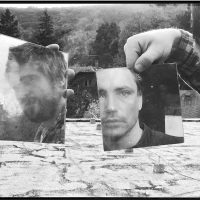János Vető was fifteen when his friendship with the young “Surrealist” painter and sculptor began. Csöme was thirteen at the time and lived in one of the workers’ apartments of the Holy Land (Szentföld) church designed by Bauhaus architect Farkas Molnár in Budapest. A later photo by Vető shows Csöme in this “magic” garden, standing in a niche of their building with the proper subcultural attributes of the era: tousled long hair and a smile. In another photo series of six images, he is running down the slope of the street, bursting with joy, until he rushes out of the frame. Vető made numerous experimental photo portraits of his friend in the seventies; these were often sequences (inspired by the photography of Jürgen Klauke and Urs Lüthi at the time) and single or compiled interventions rather than simple character analyses or projections. “I have to interfere with reality for the sake of the picture, says János Vető. I hate moments caught on camera. The camera does not peep. The camera must engage its subject. Taking a photograph is an action.”[1]
It was the establishment of a community (called Kommunart, with cinematographer Zoltán Bonta BZ) that turned this actionist basic situation of Vető and Csöme’s relationship into a Fluxus-type collaboration, in which the dominant media of photo, spatial intervention, film, and the artist’s book signaled the advances of experimental approach in Hungary. At the same time, Csöme functioned as the technical help behind the scenes in János Vető’s individual work as a photographer; he designed and implemented all of Vető’s exhibition installations. Although youth clubs, cultural centers and various ad hoc locations lacked all proper infrastructure for exhibitions, he would aim to create a state of the art display, where the mode of installation matched the spirit of the photos. Vető’s exhibition at the Bercsényi club, known as his thread exhibition, was actually an environment filling the entire space, in which a strip running along the inner surface of the structure had photos on display, while the exterior was available for viewers’ response and the free expression of opinions. So the intermediality of the photo environment was realized as an action space engaging the spectator.
János Vető introduced István Csömöri to another friend of his, Tibor Hajas. It is not widely known that Vető’s photos of Hajas’s photo actions, which were often followed by a joint selection process by the two and then authorization by Hajas, were finally glued on wood by Csöme, who prepared the final tableau format. Hajas, an extremely critical poet and performer with a sharp and precise turn of phrase, is said to have been very selective in accepting “spontaneous” friends. In Vető’s highly emotional and extremely personal shots, the selection of photos is a joyous social event, which adds significant nuance to Hajas’s dramatic aura. Seen from the vantage point of the present and the photographer’s significant involvement, absence and tragedy dominate the emotional aspect of Vető’s pictures depicting Csöme at work in Hajas’s studio or the empty studio filled with works made in collaboration (a private memorial space). The last photo before Hajas’s tragic accident in 1980, taken before he left the Makó art colony, also shows him in the company of Csöme (and artist Zsigmond Károlyi).
A symbolic moment in the collaboration of the three artists was Virrasztás/Vigil, one of the final performances of Tibor Hajas, which took place on May 18, 1980 at the Bercsényi club in Budapest and from which this exhibition takes its title. The two assistants were Csöme and János Vető. Following the administration of a sleeping aid with a short term effect temporarily stopping life functions in Hajas, they followed the script and mopped the water on the floor with Hajas’s unconscious body. Although Vető eventually defied Hajas’s will and disconnected the water from electric power, the dramatic nature of the performance was still boosted by the two men’s personal responsibility resulting from the radical vulnerability of the body. The slide show into which János Vető arranged the photos of the performance made by Tibor Zátonyi and János Szerencsés is on display now along with the audio recording of the original performance.
The cult of Hajas along with all its sensitive aspects is an unavoidable issue in the discourse of this exhibition, even though it must be emphasized that Tibor Hajas’s oeuvre and person have not been at the center of this selection. János Vető has, in fact, maintained this cult for decades, yet now, forty years later, we also find it is time one took a critical look at their collaboration, at least on this scale and at the level of inquiry. A hierarchical historical view, which came about for a number of reasons, has somewhat eclipsed Vető’s functions of initiator, assistant and photographer, which will all need to be re-interpreted in the context of relevant recent developments in contemporary theories of neo-avantgarde photography. A critical rewriting of Hajas’s oeuvre must unquestionably involve assessing the place and role of photographic interpretation beyond documentation in the performative act.
The current exhibition Vigil is also meant to contribute to this task, while attempting to bring together a remembrance of István Csömöri ‘Csöme,’ who passed away in 2015, the possible/impossible access to a long submerged underground, and intervention by critical art history discourses. The photos from János Vető’s archive on display at the exhibition are presented in a way that consciously references the unique spirit of Csöme’s installations, and the majority of the pictures are shown in public for the first time.
